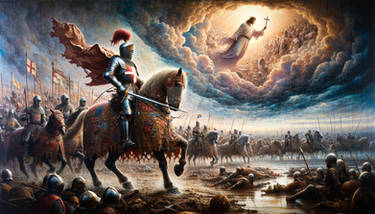ShopDreamUp AI ArtDreamUp
Deviation Actions
Description
Sancho VII Sánchez (1157[1] – 7 April 1234), called the Strong (el Fuerte in Spanish, Santxo Azkarra in Basque) or the Prudent, was the King of Navarre from 1194 to his death. His retirement at the end of his life has given rise to the alternate nickname el Encerrado or "the Retired."
He was probably the eldest child of Sancho VI and Sancha, daughter of Alfonso VII of León, born soon after their marriage, probably in Tudela, their usual residence. He was the last legitimate male-line descendant of the first two dynasties of kings of Navarre, the Houses of Íñiguez and Jiménez. He was the elder brother of Berengaria, who was married to Richard I of England in 1191 on the island of Cyprus on the way to the Holy Land for the Third Crusade. Sancho and Richard were reputed to have been good friends and close allies, even before the marriage brought them together. The French took advantage of Richard's captivity in Germany and captured certain key fortresses of the Angevin dominions including Loches. When Richard returned to his continental lands in 1194, the knights of Sancho were besieging the castle for him. As soon as Richard arrived though, Sancho was forced to return to Navarre at the news of the death of his father. He was crowned in Pamplona on 15 August.
He arrived late at the Battle of Alarcos in 1195 and thus ruined good relations with the Castilian sovereign Alfonso VIII. The ensuing confrontation resulted in Sancho devastating Soria and Almazán and Alfonso accepted the Peace of Tarazona.
Sancho made expeditions against Murcia and Andalusia, and, between 1198 and 1200, he campaigned in Africa, probably in the service of the Almohads, whose help he wanted against Castile. Taking advantage of his absence, Alfonso VIII of Castile and Peter II of Aragon invaded Navarre, which lost the provinces of Álava, Guipúzcoa, and Biscay to Castile. These conquests were subsequently confirmed by the Treaty of Guadalajara (1207).
His leadership was decisive in the Battle of Las Navas de Tolosa in the year 1212. In that engagement, the Christian forces of Sancho, Alfonso, Afonso II of Portugal, and Peter II of Aragón allied to defeat the forces of the Almohad Caliph Muhammad an-Nasir. Sancho's troops cut the chains guarding the tent of Miramamolín. For this, it is believed the chains became the symbol of Navarre and replaced the sable eagle on a golden field with a golden chain on a gules field in the Navarrese coat-of-arms. But others suspect they represented the Basques' star-like Sun of Death seen on their Hilarri (Basques' Stelae) or houses traditionally for protection, and perhaps painted on their shields too with the same religious purpose, meaning of Life or Death, or the new Imagery used for Jesus or Christianity as for others were the Christi Anagram or plain Cross on the shield.
He was probably the eldest child of Sancho VI and Sancha, daughter of Alfonso VII of León, born soon after their marriage, probably in Tudela, their usual residence. He was the last legitimate male-line descendant of the first two dynasties of kings of Navarre, the Houses of Íñiguez and Jiménez. He was the elder brother of Berengaria, who was married to Richard I of England in 1191 on the island of Cyprus on the way to the Holy Land for the Third Crusade. Sancho and Richard were reputed to have been good friends and close allies, even before the marriage brought them together. The French took advantage of Richard's captivity in Germany and captured certain key fortresses of the Angevin dominions including Loches. When Richard returned to his continental lands in 1194, the knights of Sancho were besieging the castle for him. As soon as Richard arrived though, Sancho was forced to return to Navarre at the news of the death of his father. He was crowned in Pamplona on 15 August.
He arrived late at the Battle of Alarcos in 1195 and thus ruined good relations with the Castilian sovereign Alfonso VIII. The ensuing confrontation resulted in Sancho devastating Soria and Almazán and Alfonso accepted the Peace of Tarazona.
Sancho made expeditions against Murcia and Andalusia, and, between 1198 and 1200, he campaigned in Africa, probably in the service of the Almohads, whose help he wanted against Castile. Taking advantage of his absence, Alfonso VIII of Castile and Peter II of Aragon invaded Navarre, which lost the provinces of Álava, Guipúzcoa, and Biscay to Castile. These conquests were subsequently confirmed by the Treaty of Guadalajara (1207).
His leadership was decisive in the Battle of Las Navas de Tolosa in the year 1212. In that engagement, the Christian forces of Sancho, Alfonso, Afonso II of Portugal, and Peter II of Aragón allied to defeat the forces of the Almohad Caliph Muhammad an-Nasir. Sancho's troops cut the chains guarding the tent of Miramamolín. For this, it is believed the chains became the symbol of Navarre and replaced the sable eagle on a golden field with a golden chain on a gules field in the Navarrese coat-of-arms. But others suspect they represented the Basques' star-like Sun of Death seen on their Hilarri (Basques' Stelae) or houses traditionally for protection, and perhaps painted on their shields too with the same religious purpose, meaning of Life or Death, or the new Imagery used for Jesus or Christianity as for others were the Christi Anagram or plain Cross on the shield.
Image size
1587x1244px 965.28 KB
© 2009 - 2024 Gixajin






























